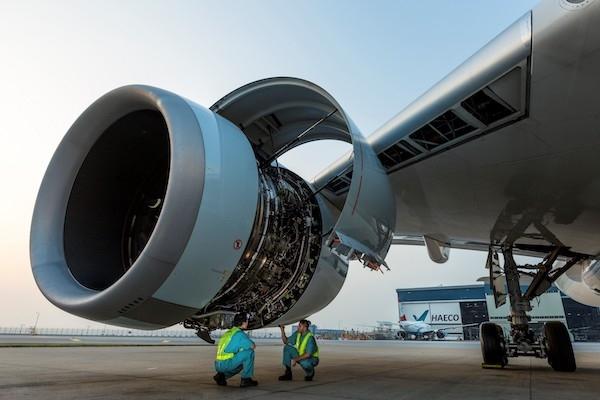
The virus crisis has been like no other crash in aviation markets. Short term, carriers have been drawing down inventories to conserve cash and swapping many components from grounded to flying aircraft. Medium term as airlines recover, Oliver Wyman forecasts a significant lag in MRO spending on engines and expensive-to-repair components, including landing gear and APUs, as carriers rotate these items in their own fleet and acquire green-time assets on the open market.
That will pose challenges to aftermarket companies, which will face less demand for full overhauls, but perhaps more for other services.
Tom Slattery, EVP of GECAS Engines acknowledges, “All roads seem to lead to a growth in green-time leasing of engines.” But Slattery says there are a number of barriers to successful green-time leasing.
First, “the technical standard of ex-installed engines has to be conformed to a lease engine standard, introducing additional inspections, part traceability and records history, all of which can be difficult to meet,” Slattery argues. Second, an engine owner must have access to operators that will pay for engine usage. “Lease documents have specific clauses that protect aircraft owners’ interests and constrain flexibility to install alternative engines.” For example, there is considerable variability in engine time on wing that can be achieved.
Finally, access to capital, credit standing and technical risk make green-time leasing difficult for investors. There will likely be some speculators entering the market, but green-time offers demand expertise to manage value volatility, weak credits and technical risk in the face of declining asset value.
Slattery predicts that green-time leasing will wane as schedules resume as more engines require overhauls. “Yet in the near term, an opportunity exists for operators to control maintenance spending and conserve cash.” He expects airlines to continue optimizing green time for engines within their own fleets. But he says they will look to established lessors like GECAS when they have to go outside for green-time optimization. “For GECAS, this activity is embedded in standard practices for optimization of aircraft investment and support of our customer base.”
The same logic applies to smaller engines. For example, Falko specializes in CF34-8s and 10s used on CRJs and EJets. “We have a number of good engines available to lease,” Chief Commercial Officer Mark Hughes.
Hughes is expecting demand for green-time leasing once airlines begin operating at a higher capacity level. He also thinks demand for both -8s and -10s will be strong as utilization of the larger regional aircraft they power has been relatively stronger in recent months.
Falko is getting some enquiries about green-time assets now, but carriers are still operating at too low levels to generate real demand right now. “There’s still too much uncertainty,” Slattery says. Nevertheless, in addition to its current portfolio of engines, the company is actively looking to acquire more.
Scott Ingold, general manager of landing gear at AAR, expects carriers to minimize spending on high-cost gear repairs. “If they can swap gear from one plane to another because they are planning on keeping that plane grounded for a while longer, it would be a good option for them.”
But airlines also know that gear can time out and cannot be flown any longer. “If an airline does not repair gears or plan their maintenance very carefully, they will end up underutilizing their fleet when they need it most, waiting on suitable gear,” Ingold says.
AAR thus offers full-service options for landing gear repair and overhaul. One useful and inexpensive option is certifying gears to be time-continued. This includes a general visual inspection, a seal change and certification for continued safe flying for the remaining time between overhauls.
In the near term, Ingold expects narrowbody and regional fleets to generate the strongest demand for green-time gear. “For larger aircraft, the gear changes are more difficult and costly, which makes this option less desirable.”
Leasing landing gear would be another option than green-time gear. Leases could last as long as the green time left on the gear, but would typically be for the time that operators are less sure about the future of their fleet. “My best estimate would be 24-36 months,” Ingold says.
AAR is not expecting to lease out green-time gear itself. Ingold says the company is focusing on getting gear fully overhauled for customers. “However, we are fully prepared to perform the time-continue services for customers, should that be the best option for their fleets and operations at this time.”
Ray Boyd, a senior director at Honeywell Aerospace’s Engines & Power Systems unit agrees that, “It makes sense that airlines and leasing companies are looking for a low-cost alternative to a higher-cost repair.”
Honeywell does not lease its APUs long term. But the OEM has a portfolio of services that may serve similar purpose as green-time leasing. It supplies spare end-unit APUs repaired or manufactured by Honeywell to MROs for lease pools and long-term lease agreements. It also offers used serviceable assets, repaired assets and new spares assets through its Honeywell Aerospace Trading, or HAT program. Indeed, HAT has created an APU flat-rate exchange program to save cash with a low-cost, flat-rate exchange option for reliable APUs on aircraft.
Boyd is expecting high demand for these cost-saving options for both its 331-200 APUs on Boeing 757s and 767s and 131-9 APUs on 737s and Airbus A319s, A320s and A321s. Honeywell is already starting to see requests from MROs to increase their asset pools supporting green-time APUs.





